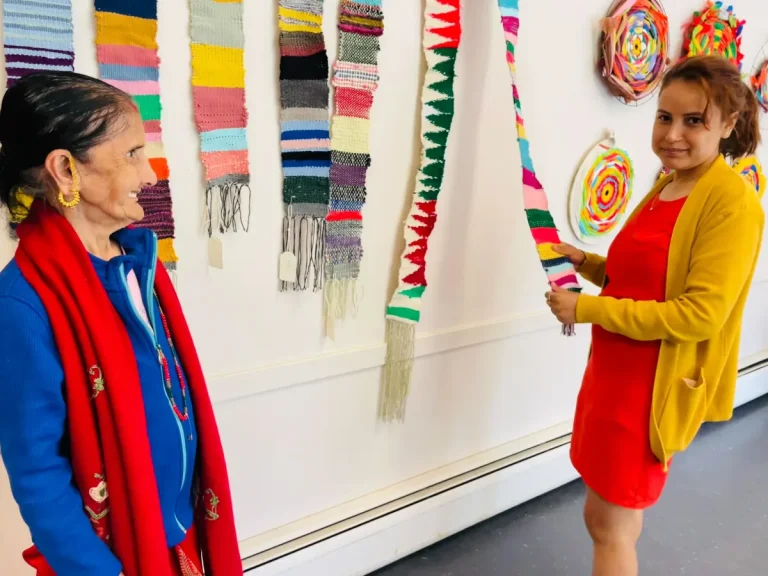At the Winooski Senior Center in Vermont, colorful strips of fabric lined the walls—each one telling a story. These were the creations of women, many of them Nepali refugees, who took part in a backstrap weaving project that brought culture, memory, and community to life.
One of the participants, 66-year-old Sita Luitel, gently touched her woven cloth with a smile. Her daughter translated as Sita spoke about how the project made her happy. Though back problems may stop her from weaving more, it reminded her of her past.
Her daughter Hari Luitel, 25, remembered how women in Nepali refugee camps used to knit sweaters and rugs for their families. She said the workshop brought back those warm memories. The Luitel family has lived in Vermont for 14 years after leaving a refugee camp in Nepal.
The project, organized by the Heritage Winooski Mill Museum in partnership with the senior center, offered free weaving classes in May and June. Fourteen seniors from Chittenden County joined the sessions. Among them were several Nepali women who learned to weave long strips of yarn into colorful designs that symbolized different parts of their lives.
Miriam Block, director of the museum, taught the classes. She used a backstrap loom, a traditional tool that ties around the weaver’s body. She noted that many Nepali participants once weaved in refugee camps, and seeing their families watch them rediscover this skill was a powerful experience.
Block explained that while language differences made storytelling through weaving tricky, they focused on using colors to reflect the places the women had lived. Some colors and shapes, like red and green triangles, even represented symbols from the Nepali flag or reminded them of the Himalayas.
Last year, the museum also hosted a quilting project where women made squares stitched into a larger piece now hanging at the senior center. The weaving program, like the quilt, encouraged older Nepali-Bhutanese women to reconnect with their traditions.
Barbara Pitfido, the senior center’s program director, said that although it began as a simple summer activity, the weaving workshop became a space for learning, healing, and connection. Some women even took looms home to keep weaving.
Participants and their families gathered on June 12 to celebrate the end of the workshop with a lunch of traditional Nepali and Indian food. Many wore vibrant outfits blending East and West—colorful skirts, warm fleeces, and gold jewelry. Red vermillion powder marked the foreheads of married Hindu women, symbolizing pride and identity.
Beli Wagley, a Colchester resident, came to see her aunt’s weaving. She said she could tell the patterns came from Nepal just by looking at them. Her aunt, Chhali Poudel, moved to Vermont about ten years ago and took part in the workshop. Another weaver, Chhali Khadka, said through a translator that the project brought back memories of her old life, even though her stiff fingers now made it harder to weave.
Many in the Nepali-Bhutanese community came to Vermont after 2008, following nearly 20 years in refugee camps. Forced out of Bhutan in the 1990s, they found a new life in the U.S., though older generations often face isolation due to language barriers and transportation challenges. That’s why programs like this one, which provided food, materials, and transport, are so valuable, Pitfido said.
The Heritage Winooski Mill Museum plans more free art programs this summer. These include natural dye workshops using marigolds and fresh indigo, and a garden walk on dye plants. The programs are open to all seniors.
Support for the weaving project came from Age Well Vermont and a $4,000 creative aging grant from the Vermont Arts Council. The council has invested around $100,000 in similar efforts since 2021 to support seniors through the arts. A new grant cycle opens in August, and local organizations are encouraged to apply.
Through colorful threads and shared stories, the Nepali weaving project showed how art can bind generations and cultures, one stitch at a time.


